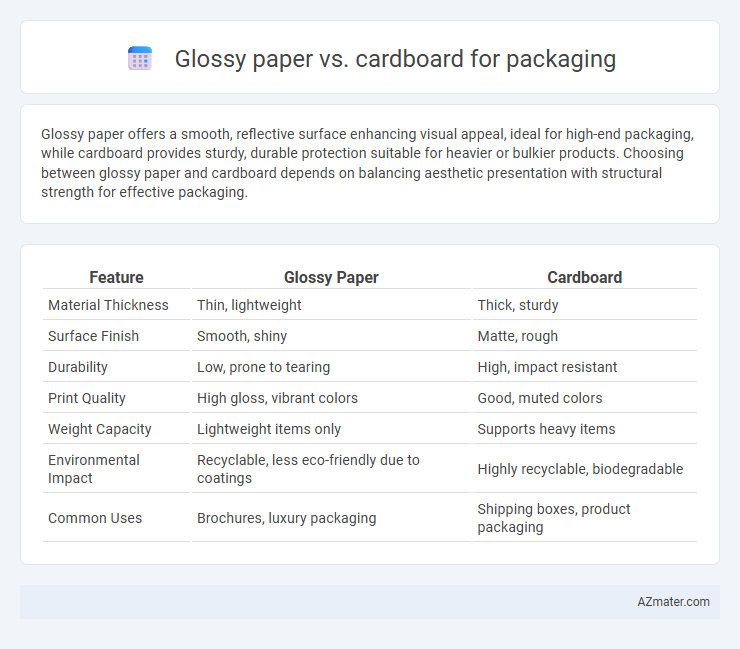Glossy paper offers a smooth, reflective surface enhancing visual appeal, ideal for high-end packaging, while cardboard provides sturdy, durable protection suitable for heavier or bulkier products. Choosing between glossy paper and cardboard depends on balancing aesthetic presentation with structural strength for effective packaging.
Table of Comparison
| Feature | Glossy Paper | Cardboard |
|---|---|---|
| Material Thickness | Thin, lightweight | Thick, sturdy |
| Surface Finish | Smooth, shiny | Matte, rough |
| Durability | Low, prone to tearing | High, impact resistant |
| Print Quality | High gloss, vibrant colors | Good, muted colors |
| Weight Capacity | Lightweight items only | Supports heavy items |
| Environmental Impact | Recyclable, less eco-friendly due to coatings | Highly recyclable, biodegradable |
| Common Uses | Brochures, luxury packaging | Shipping boxes, product packaging |
Introduction to Packaging Materials
Glossy paper offers a smooth, reflective surface ideal for high-quality printing and vibrant color reproduction, enhancing product visibility in packaging applications. Cardboard provides sturdy structural support with excellent durability and cushioning, making it suitable for protecting heavier or fragile items during shipment. Selecting the right packaging material depends on balancing visual appeal and functional strength to meet specific branding and logistical needs.
What is Glossy Paper Packaging?
Glossy paper packaging features a shiny, smooth surface achieved through a coating process that enhances color vibrancy and image sharpness, making it ideal for high-impact branding and attractive product displays. This type of packaging is lightweight yet durable enough for lightweight to medium-weight items, providing moisture resistance and a premium feel that appeals to consumers. Often used in retail sectors such as cosmetics, electronics, and food products, glossy paper packaging balances aesthetic appeal with functional protection.
What is Cardboard Packaging?
Cardboard packaging is a durable and lightweight material made from thick paper pulp, designed to provide strong structural support and protection for various products during shipping and storage. It offers excellent customization options, including printing and cutting, making it ideal for branding and product differentiation. Unlike glossy paper, cardboard packaging boasts superior rigidity and cushioning, enhancing product safety and environmental sustainability due to its recyclability.
Durability: Glossy Paper vs Cardboard
Glossy paper offers a smooth, shiny finish that enhances print quality but provides limited durability compared to cardboard, as it is more prone to tearing and moisture damage. Cardboard, made from thick, layered fiberboard, ensures superior strength and resistance to impact, making it ideal for protecting heavier or fragile items during shipping and handling. For packaging requiring long-term durability and structural integrity, cardboard outperforms glossy paper significantly.
Visual Appeal and Branding
Glossy paper enhances packaging with vibrant colors and a smooth, reflective finish that boosts visual appeal and brand recognition by attracting consumer attention. Cardboard offers a sturdy, matte surface that emphasizes a natural, eco-friendly brand image, resonating well with sustainability-focused markets. Choosing between glossy paper and cardboard impacts consumer perception, with glossy appealing to premium aesthetics and cardboard supporting authenticity and environmental values.
Printing Quality and Design Flexibility
Glossy paper delivers vibrant, high-resolution prints with excellent color accuracy and sharp detail, making it ideal for premium packaging designs requiring a polished look. Cardboard offers robust design flexibility by supporting a variety of printing techniques and finishes, including matte, textured, and embossed effects, enhancing tactile appeal and brand differentiation. Choosing between glossy paper and cardboard depends on the desired balance of visual impact and structural durability for packaging applications.
Environmental Impact and Sustainability
Glossy paper packaging often involves coatings and finishes that hinder recyclability and increase environmental burden due to the use of non-biodegradable materials and energy-intensive production processes. Cardboard, especially when uncoated and sourced from recycled fibers, offers higher sustainability with better recyclability, lower carbon footprint, and greater biodegradability. Choosing cardboard over glossy paper significantly reduces waste and supports circular economy principles in packaging industries.
Cost Comparison: Glossy Paper vs Cardboard
Glossy paper packaging generally incurs lower production costs due to its lightweight nature and simpler manufacturing process, making it cost-effective for short-term use and lightweight products. Cardboard packaging, although higher in initial material and shipping expenses due to its bulk and durability, offers better protection and reusability, often reducing long-term costs for heavier or fragile items. Businesses typically balance upfront expenses with durability needs, with glossy paper favored for economical, visually appealing packaging and cardboard chosen for its strength and higher cost but greater product safety.
Best Use Cases for Each Material
Glossy paper excels in packaging applications requiring vivid color reproduction and high visual appeal, such as luxury product boxes and promotional materials, due to its smooth and reflective surface. Cardboard offers superior structural strength and durability, making it ideal for shipping containers, heavy-duty packaging, and eco-friendly products requiring recyclability. Choosing between glossy paper and cardboard depends on balancing aesthetic presentation with functional protection in packaging solutions.
Choosing the Right Packaging for Your Product
Glossy paper packaging enhances visual appeal with vibrant colors and a smooth finish, making it ideal for premium or retail products requiring high impact shelf presence. Cardboard offers superior durability and structural support, suitable for heavier items or products needing extra protection during shipping and handling. Selecting the right packaging depends on balancing aesthetic appeal with functional requirements like product weight, protection level, and brand positioning.

Infographic: Glossy paper vs Cardboard for Packaging
 azmater.com
azmater.com